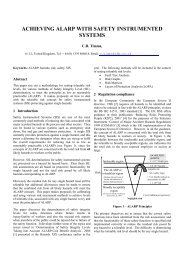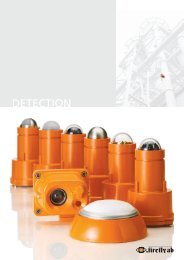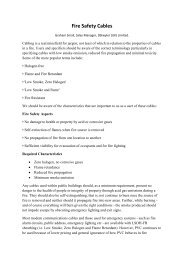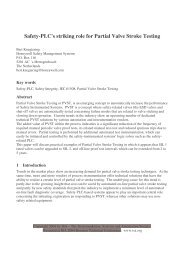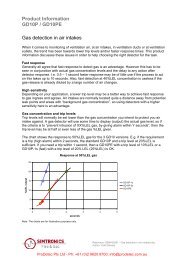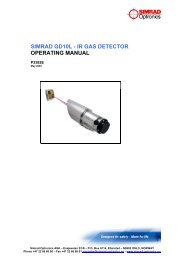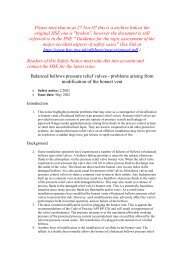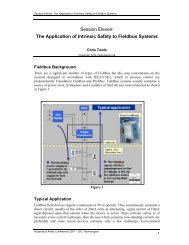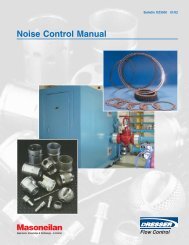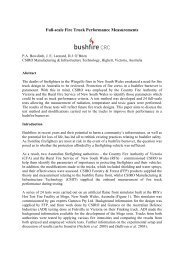Safety Considerations Guide for Triconex General ... - ICEWeb
Safety Considerations Guide for Triconex General ... - ICEWeb
Safety Considerations Guide for Triconex General ... - ICEWeb
Create successful ePaper yourself
Turn your PDF publications into a flip-book with our unique Google optimized e-Paper software.
76 Appendix B HART Communication<br />
2008-04-01<br />
Picture 1: HART usage within SIS<br />
SIS<br />
DCS, AMS,<br />
Diagnostic<br />
Monitor, or<br />
Maintenance<br />
System<br />
RS 485<br />
HART Protocol<br />
Isolator<br />
Isolator<br />
HART MUX<br />
4 – 20 mA<br />
HART Master<br />
HART<br />
Enabled<br />
Field Device<br />
SIS = <strong>Safety</strong> Instrumented System<br />
MUX = Multiplexer connectd to AMS one one side, and to<br />
4-20 mA signal on the other side.<br />
AMS = Asset Management System that is connected to<br />
MUX using RS 485. The AMS uses the HART protocol to<br />
communicate with the HART enabled device.<br />
DCS = Dstributed Control System<br />
In order to ensure that the HART Master/MUX connection to the 4-20 mA signal (input/output)<br />
connected to the SIS and use of HART protocol is non-interfering the 4-20 mA safety signal, the<br />
rules/guidelines specified in the following must be followed by the end user.<br />
Note, that the end user could incorporate some of the guidelines in the management of safety,<br />
management of change, and management of maintenance policies and procedures.<br />
4. Rules and <strong>Guide</strong>lines <strong>for</strong> the use of a HART protocol within SIS<br />
AMS/MUX connection to 4-20 mA signal must be isolated and decoupled such that a failure<br />
of the MUX does not affect the 4-20 mA signal<br />
A detailed FMEA of the MUX interface to the 4-20 mA signal must be per<strong>for</strong>med to show that<br />
the normal operation or the failure of MUX won’t affect the 4-20 mA signal. In this case, the<br />
MUX and associated AMS are non-interfering the 4-20 mA safety signal. If non-interfering<br />
can not be shown by FMEA the probability of failure must be considered to determine the<br />
safety parameters in accordance to IEC 61508 to include them into safety loop<br />
consideration.<br />
The HART enabled devices used with SIS must be suitable <strong>for</strong> the SIL rating of the safety<br />
loop as per IEC 61511 guidelines. HART enabled field devices shall be documented to be<br />
non-interfering the 4-20 mA safety signal. In compliance with IEC 61511 -1 clause 11.5.2,<br />
the HART enabled devices used within an SIS (<strong>Safety</strong> Instrumented System) shall be<br />
documented to be in accordance with IEC 61508-2 and IEC 61508-3 as applicable to the SIL<br />
(<strong>Safety</strong> Integrity Level) of the individual SIF (<strong>Safety</strong> Instrumented Function), or else they<br />
shall meet the requirements of IEC 61511-1 clause 11.4 <strong>for</strong> hardware fault tolerance and<br />
clauses 11.5.3 to 11.5.6 <strong>for</strong> prior use, as appropriate.<br />
HART_in_<strong>Safety</strong>_Related_Applications_pdf.doc<br />
Revision 1.0 Page 6 of 7<br />
<strong>Safety</strong> <strong>Considerations</strong> <strong>Guide</strong> <strong>for</strong> <strong>Triconex</strong> <strong>General</strong> Purpose v2 Systems



